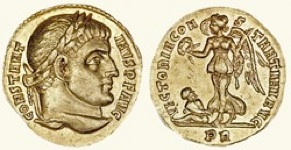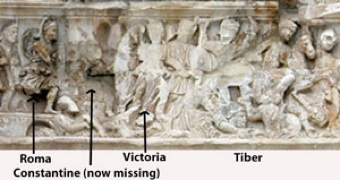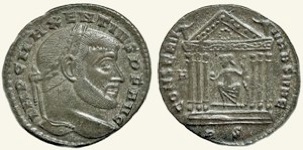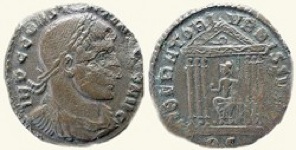Maximinus, Augustus Maximus (311-2 AD)
Battle of the Milvian Bridge (312 AD)
Home Cities History Art Hagiography Contact
Maximinus, Augustus Maximus (311-2 AD): Main Page


Maximinus, Augustus Maximus (311-2 AD)
Battle of the Milvian Bridge (312 AD)
Home Cities History Art Hagiography Contact
Maximinus, Augustus Maximus (311-2 AD): Main Page

CONSTANTINVS P F AVG/ VICTORIA CONSTANTINI AVG
RIC VI Rome 285a, 312-3 AD
After the fall of Verona (described in my page on Constantine’s Invasion of Italy), Constantine marched, apparently unopposed, along the Via Flaminia, arriving outside Rome on 27th October 312 AD. Lactantius drew attention to the significance of the date:
“The anniversary of the reign of Maxentius approached, that is, the sixth of the kalends of November, and the [sixth] year of his reign was drawing to an end” De Mortibus Persecutorum’, 44:4).
In a panegyric (Panegyric XII, translated into English in Nixon and Rodgers, referenced below) that was delivered at Constantine’s court, probably at Trier, in the year after his victory, the panegyrist remembered that:
“There was still this one fear, that ... [Maxentius] might consult his best interests and put off, by enduring a siege, the penalty owed to the Republic, since, after:
-all of Africa, which he had decided to destroy, had been exhausted; and
-all the islands [in the Mediterranean that he controlled] had been emptied;
he had amassed provisions for an unlimited length of time” (16 :1).
However, as we shall see, this one last fear of Constantine’s soon evaporated.
Maxentius’ Decision to Give Battle
The panegyrist (above) continued:
“[Fortunately for Constantine,] the divina mens (divine spirit) and the Urbis aeterna maiestas (eternal majesty of Rome) robbed the accursed man [Maxentius] of good sense and made him suddenly rush out [of the city to engage Constantine in battle]” (16 :2).
Lactantius gave an account of the circumstances in which Maxentius took this extraordinary decision: as Maxentius continued as normal, safe within the city walls:
“... a sedition arose at Rome, and Maxentius was reviled as one who had abandoned all concern for the safety of the commonweal; and suddenly, while he exhibited the circensian games on the anniversary of his reign, the people cried with one voice:
‘Constantine cannot be overcome!’
Dismayed at this, Maxentius burst from the assembly and, having called some Senators together, ordered the Sibylline books to be searched. In them it was found that:
‘On the same day the enemy of the Romans should perish’.
Led by this response to the hopes of victory, he went [to join his army in] the field”, (‘De Mortibus Persecutorum’, 44: 7-8).
This suggests the following scenario: Maxentius had originally hoped (not unreasonably) that Constantine would soon withdraw rather than face a winter away from Gaul. He planned to show his confidence to the Romans by celebrating his natalis imperii (anniversary of accession) in the usual way. However, he suddenly faced a riot by a mob that alerted him to the dangers within the city. The Sibylline books seemed to offer an alternative, provided, of course, that one assumed (as Maxentius surely did) that “the enemy of the Romans” meant Constantine. Thus, it must have seemed that the safer and the more profitable option would be for him to emerge from the city and confront Constantine in battle.
Betrayal of Maxentius ?

Constantine outside Rome: relief from the Arch of Constantine
Detail of the illustration of the full relief (below)
One wonders what caused the riot in the circus that precipitated Maxentius’ sudden disastrous decision. David Potter suggested:
“Treason may well have been in the air: many of Maxentius' associates would rapidly find places in the highest echelons of Constantine's régime, which suggests that negotiations may have been opened between their houses and his camp as he moved south.”
Noel Lenski (referenced below) speculated on the form that this putative betrayal might have taken. His starting point was the claim that was later made in the inscription (315 AD) on the celebratory Arch of Constantine, to the effect that Constantine had defeated Maxentius, at least in part, by ‘instinctu divinitatis’ (the instigation of the divine). Lenski’s paper (as summarised in its opening abstract) concluded, on the basis of a philological examination of this phrase, that the inscription:
“... deploys the language and concepts of evocatio [the ritual calling of the protective deity of a city to - or, in this case, away from - Rome] in order to explain how Constantine succeeded in overcoming a foe who had relied on the protection of the Urbs Roma.”
Lenski observed that:
“While maintaining the religious taboo against naming the tutelary divinity of the Urbs Roma, the panegyrist has conveyed perfectly the notion that Constantine had succeeded in calling it forth from Rome’s walls. In so doing, he not only deprived Maxentius of the protective power he had enjoyed during the [previous attacks on Rome] by Severus and Galerius, but he also spared Rome’s protective deity from further disgrace and realigned it with his own cause.”
This protective deity could only be the goddess Roma. In support of this interpretation, Lenski noted that:
“In the Constantinian relief depicting the Battle of the Milvian Bridge on the ... south face [of the Arch of Constantine, illustrated above], Constantine ... was portrayed standing along the very edge of the severed bridgehead before a river [the Tibur] choked with drowning Maxentian soldiers. At his left stood the goddess Victory and, at his right, the goddess Roma. [The latter] was thus ranged on Constantine’s side, both figuratively and literally, for she stood across the banks of the Tiber from her own walls during the battle.”
He reasonably suggested that Roma could be recognised as the Urbis aeterna maiestas (eternal majesty of Rome, in Panegyric XII, quoted above) who had robbed Maxentius of good sense and made him suddenly rush out of the city to meet his fate.
Roma

IMP C MAXENTIVS P F AVG/ CONSERV VRB SVAE (RIC VI Rome 202a, 307-8 AD)
Noel Lenski was at pains to stress (in his abstract and in his concluding paragraphs) that he was not contending that the ritual of the evocatio of Roma had actually taken place. Had it done so, the most important cult image of Roma - the cult statue in ‘her part’ of the double Temple of Venus and Roma - would have had to be persuaded to voluntarily leave her temple and cross the river to Constantine’s camp. Maxentius’ restoration of this temple was included among his principal achievements in the short imperial biographies included in the so-called ‘Chronograph of 354 AD’, in much the same way as Hadrian’s original construction of the temple was also recorded there:
“While [Hadrian] was ruling, the templum Romae et Veneris was built”.
“While [Maxentius] was ruling, the templum Romae burned down and was rebuilt”.
Maxentius had frequently celebrated the restored temple and its cult statue on his coins, beginning with those that he minted early 307 AD (presumably immediately after its restoration). Philip Hill ( referenced below, at p 17) pointed out that:
“Since all the coins on which [a cult statue of] the goddess appears after 307 AD [for Maxentius’ own coins, see these pages of the OCRE database] show her holding a globe [instead of the Palladium, as had been usual in the previous century], it may well be that Maxentius had to furnish the rebuilt temple with new cult statues.”
Thus, Constantine (or his agents) would have had to remove the cult statue that Maxentius had probably commissioned from the temple that he had restored, which stood at the heart of the besieged city. One can well see that that would not have been easily achieved.
Having said that, in Panegyric XII (as above), the panegyrist gloated that, as Constantine approached the city:
“[Maxentius] did not realise that the maiestatem illam urbis [the city’s majesty, presumably Roma] ... had gone over to support you [Constantine], now that [she] was disgraced by [Maxentius’] crimes and driven from [her] seat” (12: 15:1).
Did he mean that Maxentius had driven Roma from her original location ?? If so, he can only have referred to the statue holding the Palladium, which he had replaced. I wonder if it was this original cult statue that had found its way to Constantine (or at least, had been hidden, so that Constantine’s agents could pretend that it had left the city for his camp). If so, then the news could easily have provoked the riot that led Maxentius to join his army outside the city.

IMP C CONSTANTINVS P F AVG/ LIBERATORI VRBIS SVAE
RIC VI Rome 304, 312-3 AD
It is perhaps significant in this context that, after Constantine’s victory, he soon issued coins from his newly acquired mint at Rome that repudiated Maxentius’ claims to be its ‘conservator’ (in coin illustrated above) and instead adapted its reverse of the Temple of Venus and Roma in order to proclaim himself as liberator or restorer of his city (in RIC VI 303-4 and 312).
Identities of the Putative Betrayers
A comment in a late panegyric (Panegyric IV, translated into English in Nixon and Rodgers, referenced below, which was delivered in Rome in 321 AD) reveals that, when Constantine entered Rome after his victory:
“Barbarians were not cast into prison [as was usually the case following a triumph], but [on the contrary] ex-consuls were led out of [prison]” (31:1).
Ex-consuls must have been quite rare in Rome at this time: only four non-imperial designations had been made in the previous decade, and two of these, the ‘legitimate’ Praetorian Prefects:
-Tatius Andronicus; and
-Pompeius Probus, whom Galerius had designated in 310 AD:
were most unlikely to have appeared in Maxentian Rome. This leaves two interesting candidates for the consuls that Maxentius had imprisoned prior to the battle: those whom Maxentius himself had appointed for the last four months of 311 AD:
-Aradius Rufinus; and
-Ceionius Rufius Volusianus.
This hypothesis is supported by the facts that:
✴Aradius Rufinus was relieved of his post as Urban Prefect on 27th October and replaced by Annius Anulinus: had his loyalty not been in doubt (indeed, had he not, quite probably, been in prison), one might have expected his term to have been extended rather than terminated as Constantine marched on Rome;
✴both Aradius Rufinus and Ceionius Rufius Volusianus achieved prominence in what David Potter described (above) as “the highest echelons of Constantine's régime”; and
✴they also featured (together with Vettius Cossinius Rufinus) in Noel Lenski’s list of former supporters of Maxentius who subsequently found favour with Constantine.
Noel Lenski pointed out (at p. 219) that the men who were to design the Arch of Constantine (and who were thus to be responsible for its iconography) must have been:
“... the most prominent senators of Rome in the years in which it was constructed (312-5 AD). This means the likes of Aradius Rufinus, Rufius Volusianus, and Vettius Cossinius Rufinus, the former supporters of Maxentius ...”
These were thus probably the men who had portrayed Constantine’s victory in terms that attributed it, at least in part, to Roma’s decision to leave Rome. Perhaps they were congratulating themselves on their successful subterfuge ??
On this model, Maxentius had the two ex-consuls arrested when he discovered that their machinations had inspired the riot at the circensian games. It is possible that he also now consulted the Sibylline books, as Lactantius claimed. If so, Volusianus’ colleagues among the XVviri sacris faciundis (the priestly college with oversight of the Sibylline Books) presumably ensured the discovery of a suitably ambiguous prophecy, and his fate was sealed.
Details of the Battle

Battle of the Milvian Bridge: relief from the Arch of Constantine
In 2006, the archeologist Clementina Panella announced the discovery of what seems to be the remains of a collection of imperial regalia (4th century AD) that had been hidden on the slopes of the Palatine (now exhibited in ‘Sala D’ of the Museo Nazionale Romano, Palazzo Massimo alle Terme). She suggested that it might have belonged to Maxentius, and that it had been hidden in a shrine here prior to the battle. If so, Maxentius must have doubted that he would be returning to collect it.. He then marched out of Rome and took charge of an army for what was probably the first and last time in his life. The date was 28th October, the sixth anniversary of his coup.
Maxentius seems to have rendered the Milvian Bridge unusable, preferring to rely on a temporary structure that he could destroy to cover any retreat. This contingency was soon needed: according to Zosimus:
“As long as [Maxentius’] cavalry kept their ground, [he] retained some hope, but when they gave way, he fled with the rest over the [pontoon] bridge into the city. The beams not being strong enough to bear so great a weight, they broke; and Maxentius, with the others, was carried with the stream down the river” (‘Historia Nova’, 2:17, search on ‘beams’).
In the iconic image above, Constantine is flanked by Victory and Roma (as discussed above) on the far bank of the Tiber as the pontoon gives way and Maxentius and his army are swept into the river. Thus was the inglorious end of the six year reign of the last emperor who had actually resided in Rome.
There is, of course, a vast literature on the impact that Constantine’s apparent conversion to Christianity at about this time had upon:
✴the morale of his soldiers and his own expectation of victory, and thus the outcome of the battle; and
✴the way he was subsequently received and perceived in Rome.
Those intent upon penetrating this crucial but difficult area might usefully start with the important books by David Potter (2013, referenced below, at pp 150-9) and by Timothy Barnes and Raymond Van Dam (both published in 2011 and referenced below).
In the aftermath of the battle, Constantine now made use of his newly-acquired mint at Rome to mint for himself and his colleagues, Maximinus and Licinius. These early Roman coins also included reverse legends for deities that had presumably helped him to victory:
✴Jove (RIC VI Rome 282);
✴Mars (RIC VI Rome: 283 and 305-11);
✴Victoria (RIC VI Rome 285-6) one of which include the coin illustrated above, and RIC VI Rome 353-4);
✴Hercules (RIC VI 298-300);
✴Roma, on coins with reverse legends that proclaimed him as liberator or restorer of his city (RIC VI 303-4 and 312); and
✴Sol Invictus (RIC VI 313-44), who was represented on the great majority of these issues, seconded into Constantine’s court as a comes.
Read more:
D. Potter, “Constantine the Emperor”, (2013) Oxford
T. Barnes, “Constantine: Dynasty, Religion and Power in the Later Roman Empire”, (2011) Chichester
R. Van Dam, “Remembering Constantine at the Milvian Bridge”, (2011)
N. Lenski, “Evoking the Pagan Past: Instinctu Divinitatis and Constantine’s Capture of Rome”, Journal of Late Antiquity, 1:2 (2008) 204-57
C. E. V. Nixon and B. S. Rodgers, “In Praise of Later Roman Emperors: The Panegyrici Latini”, (1994) Berkeley
P. Hill, “The Monuments of Ancient Rome as Coin Types”, (1989) London
Maximinus, Augustus Maximus (311-2 AD)
Maxentius in Rome: (311-2 AD) Maxentius' Consecration Coins (311 AD)
Maxentius' Rotunda on the Sacra Via Maxentius and the Gens Valeria
Literary Sources: Diocletian to Constantine (285-337 AD)
Return to the History Index